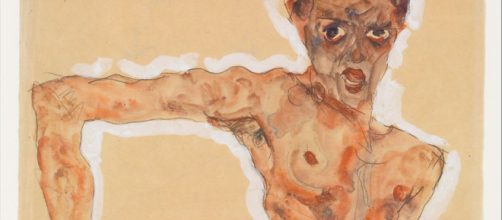Will the real Egon Schiele please stand up?
"The Unflinching Eye of Egon Schiele: Works of a Private Collector," now showing at Bonhams in London, prompts the identity question because his art says one thing, and his words say another. And the often-repeated fact that he was inspired by the writings of Sigmund Freud doesn't explain the contradiction.
Danielle Knafo's 1993 book "Egon Schiele: A Self in Creation - A Psychoanalytic Study of the Artist's Self-Portraits" goes on and on about how his "countless anguished self-images" tie to Freudian psychology.
In the flesh
Granted, Schiele's "Self-Portrait," – one of dozens – describes a skin-and-bones figure in profile and bent, as if too overwhelmed and weak to stand.
And at each of the joints of his body, he colored it the shade of raw flesh, as if to convey pain. In another self-portrait, you see Schiele in a twisted, torturous pose. So, you'd take from such imagery that he was riddled with anxiety.
But he doesn't sound the way he pictures himself in a letter to a friend cited by Alesandra Comini in her 2014 book "Egon Schiele Portraits." Instead, he sounds peevish, entitled and quite full of himself:
"I am chained," he said when he ran out of money and art supplies. "Will no one help me? If only I could have an exhibition, I would be out of it.
But no, I can't even draw, so I must write to borrow money now, in the best years and days I want to work..."
Schiele went on like this about his financial straits, asking his friend what he should do: "Should I become a merchant or a salesman? Who will help me: I can't buy a single canvas. I want to paint but have no colors...The artist should at least not have to worry every month about getting the money owed to him?"
He died young, at age 28, so you'd think that with his money woes, he'd have done little artwork.
But as the Met, owner of one of his self-portraits, notes on its website, he produced more than 300 paintings and several thousand works on paper, all showing "emaciated, tortured figures."
He ends his whining letter about the lack of funds to buy supplies like this: "I am extremely sensitive, and all these people have absolutely no idea how they should behave towards an artist."
Given Schiele's senses of self-importance, a note he sent his mother is not as astonishing as it seems.
Comini cites the missive: "Without a doubt I shall be the greatest, the most beautiful, the most valuable, the purest, and the most precious fruit... I shall be the fruit which after its decay will still leave behind eternal life; therefore how great must be your joy – to have borne me." See? No angst, just arrogance.
This is not to say that Schiele was or is the only artist who painted one way and talked another. When Picasso came to see Miro's work – a dream world filled with biomorphic organisms – he recalled the reaction in the film "Picasso: A Painter's Diary":
"That's pure poetry," Picasso said. "I always remembered this remark," Miró recalled, "because Picasso was constantly wanting to advance beyond painting into poetry, music, and other fields, not to remain stuck with pictorial art." Say what?
Picasso painting non-pictorials? He was a painter whose imagery is, if nothing else, every inch pictorial. I'm thinking of his "Crying Woman." The level of agitation is made visceral when he showed the women torn apart by emotions. Way more pictorial than poetry.
I leave you with two hackneyed sayings – talk is cheap, and pictures don't lie – and contend that in each case, the opposite is true when it comes to Shiele's words and pictures.


